David Bowie’s Early Websites, 1995–1997: Outside to Earthling
During the mid-90s, David Bowie's website went from a storytelling structure for the Outside album, into a striking, grunge-inspired design for Earthling. At the same time, Bowie fan sites emerged.
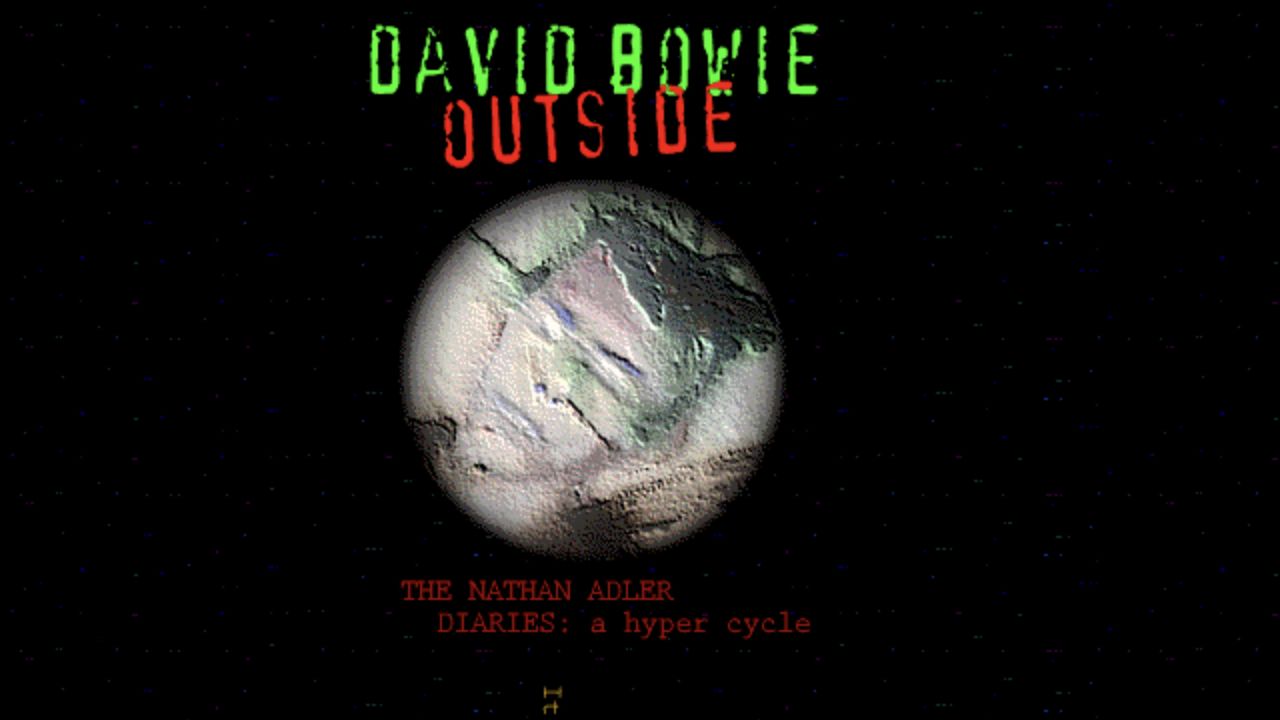
As the internet became more interactive over 1995, it became a more attractive place for musicians to set up a web presence. David Bowie was one of the first to do this.
On August 6, 1995, the domain www.davidbowie.com was registered on the World Wide Web. In September — most likely coinciding with the release of his new album, Outside, on 25 September 1995 — Bowie's first website went live. Up till recently, this version had been lost to time (the first Wayback Machine copy isn't until October 1996). But last November, a Reddit user with the handle JustMyselfAndI announced a restored version of the original 1995 site.
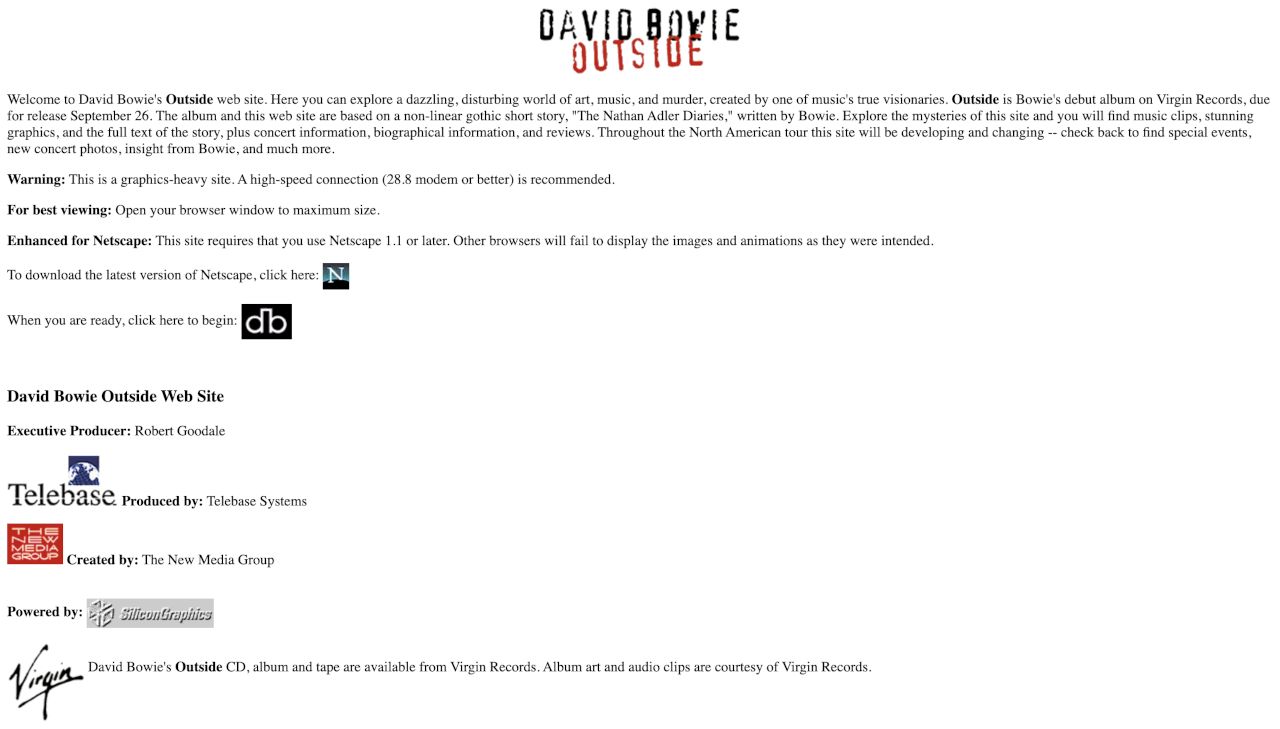
If you click the little "db" icon on the homepage, you're taken to a much different-looking site. With its dark patterned backgrounds and various coloured fonts (green, red, yellow, purple), the site proceeds to tell the story of "The Nathan Adler Diaries," the conceptual basis for Outside.
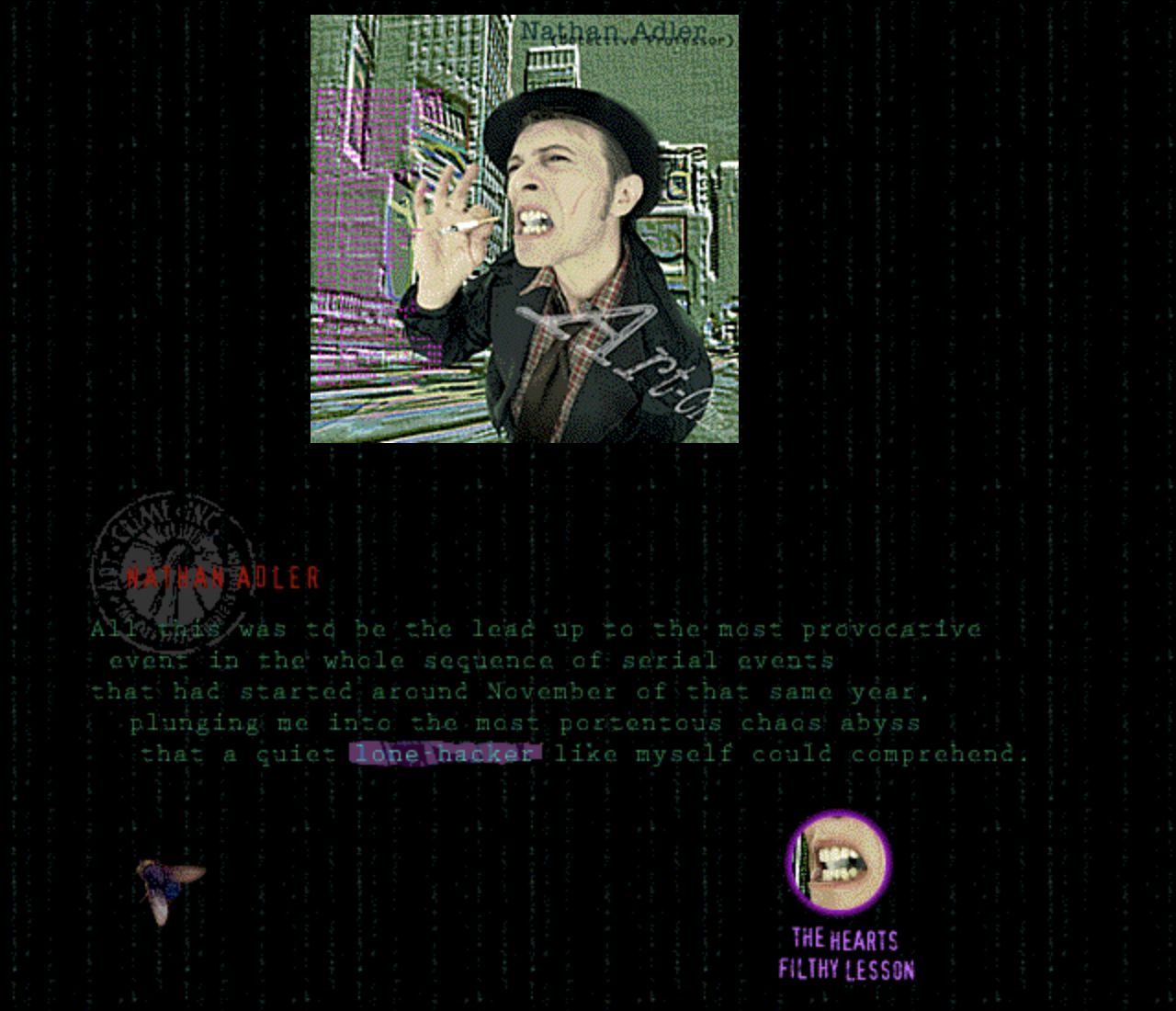
JustMyselfAndI made these comments about the structure:
"The site was quite revolutionary for the time, even if it might not seem like it - vertical scrolling structures were not common, and it was unconventional to structure a site in such a way to bury subpages within other pages with no clear site map or index. It's quite fitting for the narrative and allure of Outside [...]"
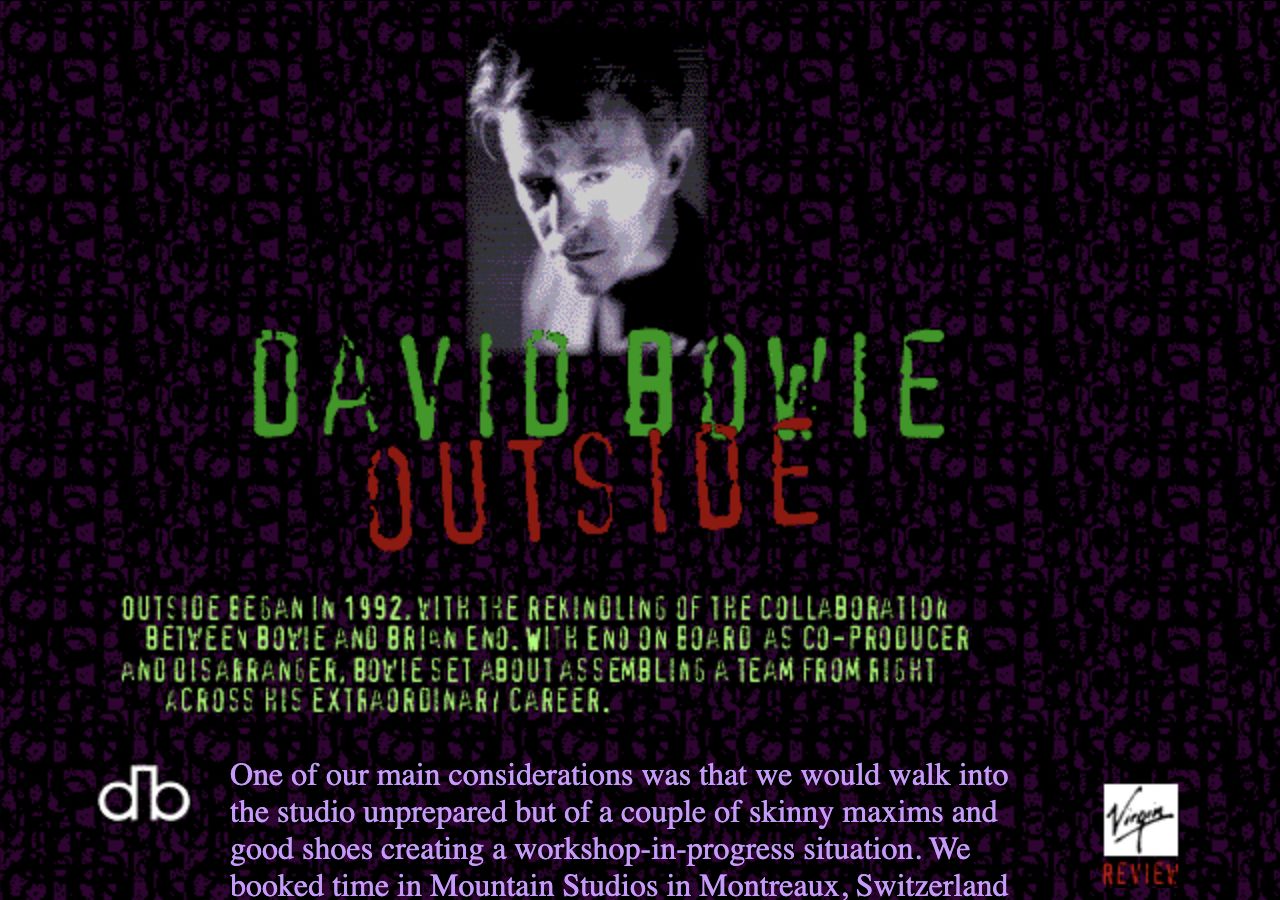
One of the designers of the website, Michael Endres, added more context on the restoration on LinkedIn. He noted that his company at the time, The New Media Group, had started work on the website in July 1995, "just a few weeks after Netscape 1.1 was released." The intention was to "create an image heavy website that would bring your 1400 baud modem to a crawl." He added that the site "was intentionally obscure and 'experiential'."
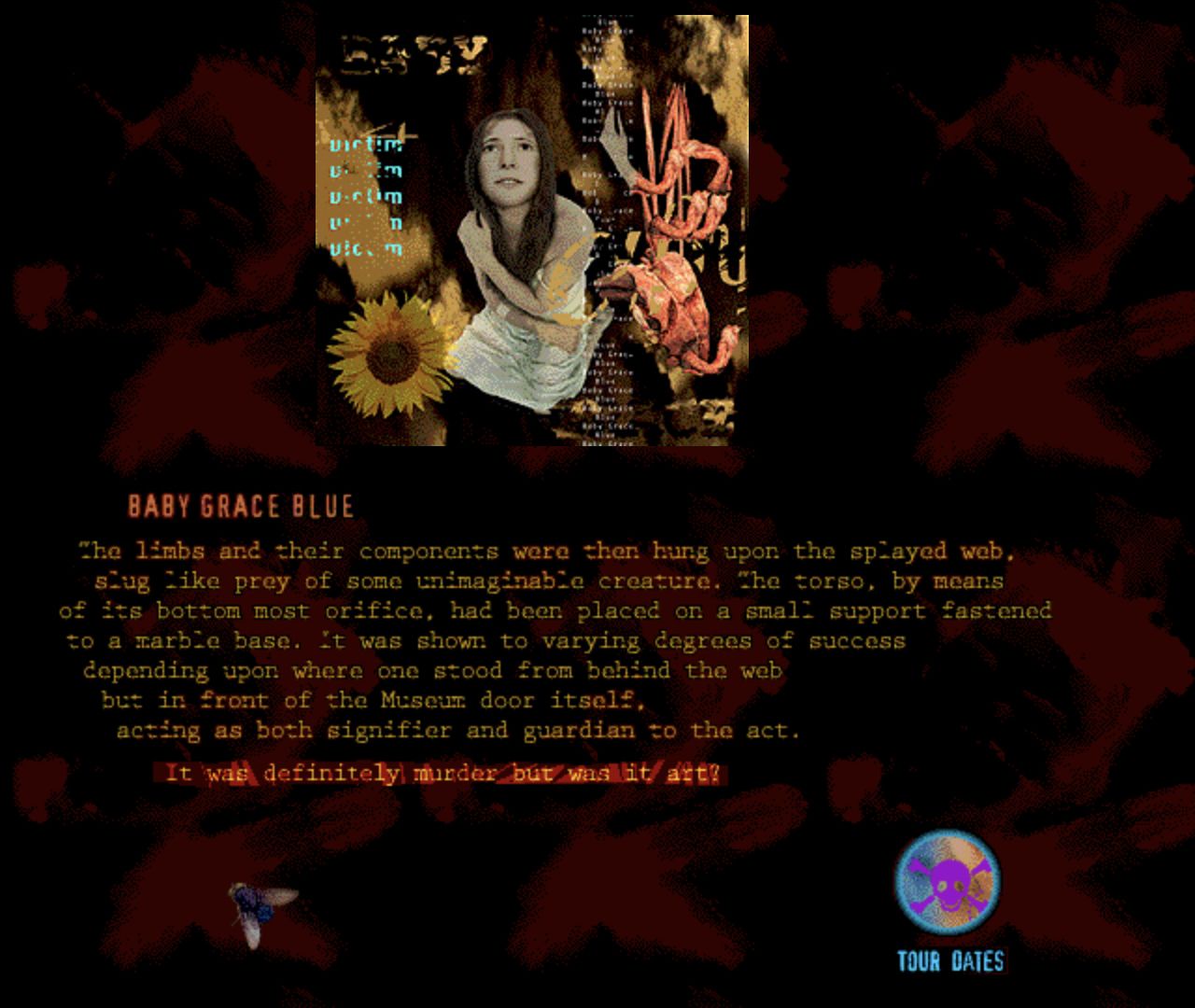
Bowie's Website v1.5
Sometime in late-1995 or early 1996, Bowie's record company Virgin Records contracted another design company, N2K, to do further work on the site. N2K — which stood for “Need To Know” — was well connected in both the music industry and the burgeoning dot-com industry. Among other things, it had links to a pioneering music e-commerce site founded in August 1995 called Music Boulevard. (I'll have more to say about N2K in a future article.)
As for Bowie himself, he was focused on recording his drum and bass album, Earthling, during 1996 — he’d completed the first song, Telling Lies, in April and would complete the entire album by October. So his involvement in internet activities over 1996 was minimal. But fortunately he had a tech-savvy business partner, Robert Goodale, who managed his online presence.
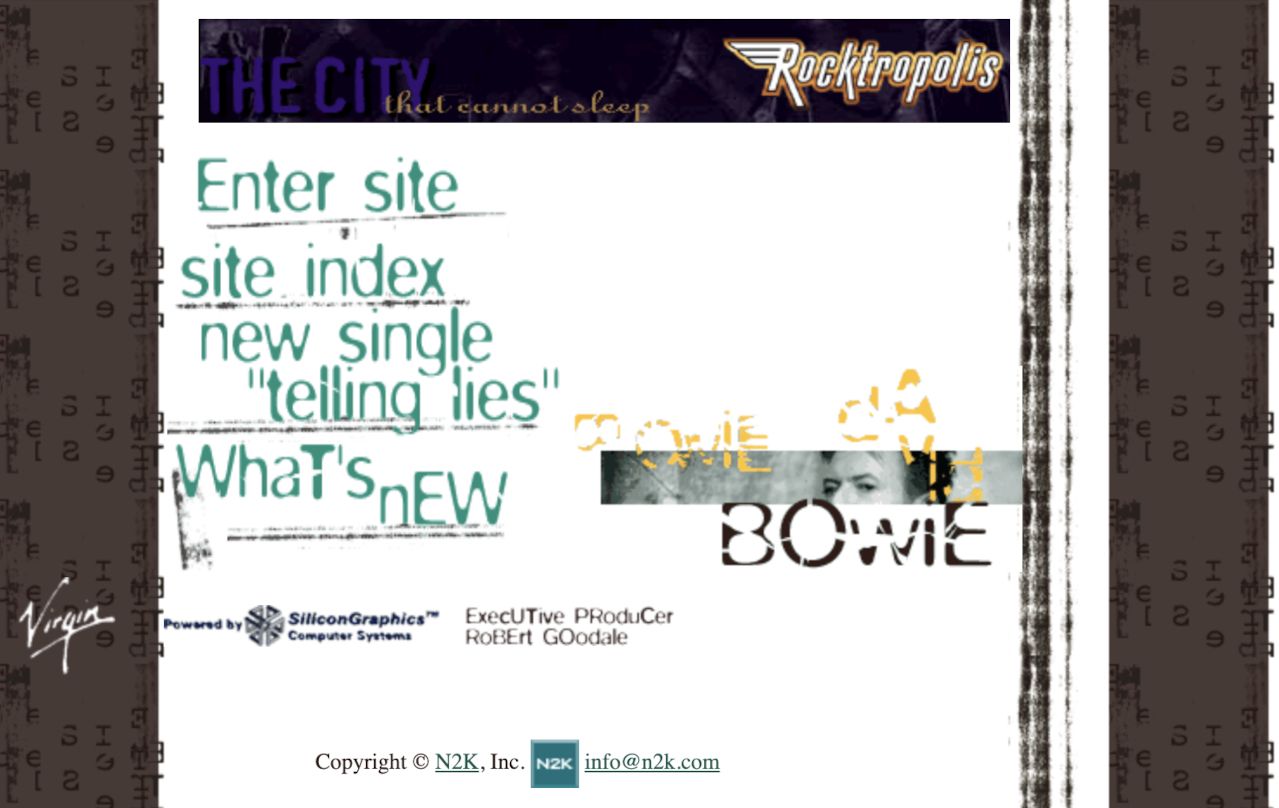
Under Goodale's direction, N2K added some new features to Bowie's Outside website — primarily, navigation. As Reddit user JustMyselfAndI commented, "later versions of davidbowie.com had parts of the original Outside site reformed and reconfigured with an index to allow for easier navigation."
According to a September 1996 edition of Billboard, the site at this time contained “extensive information about the artist, including tour dates, photographs, audioclips, cover art, biographies, and a fan bulletin board.” Unfortunately, the Wayback Machine has preserved very little of it, largely due to the site's reliance on now-defunct interactive technologies like server-side image maps.
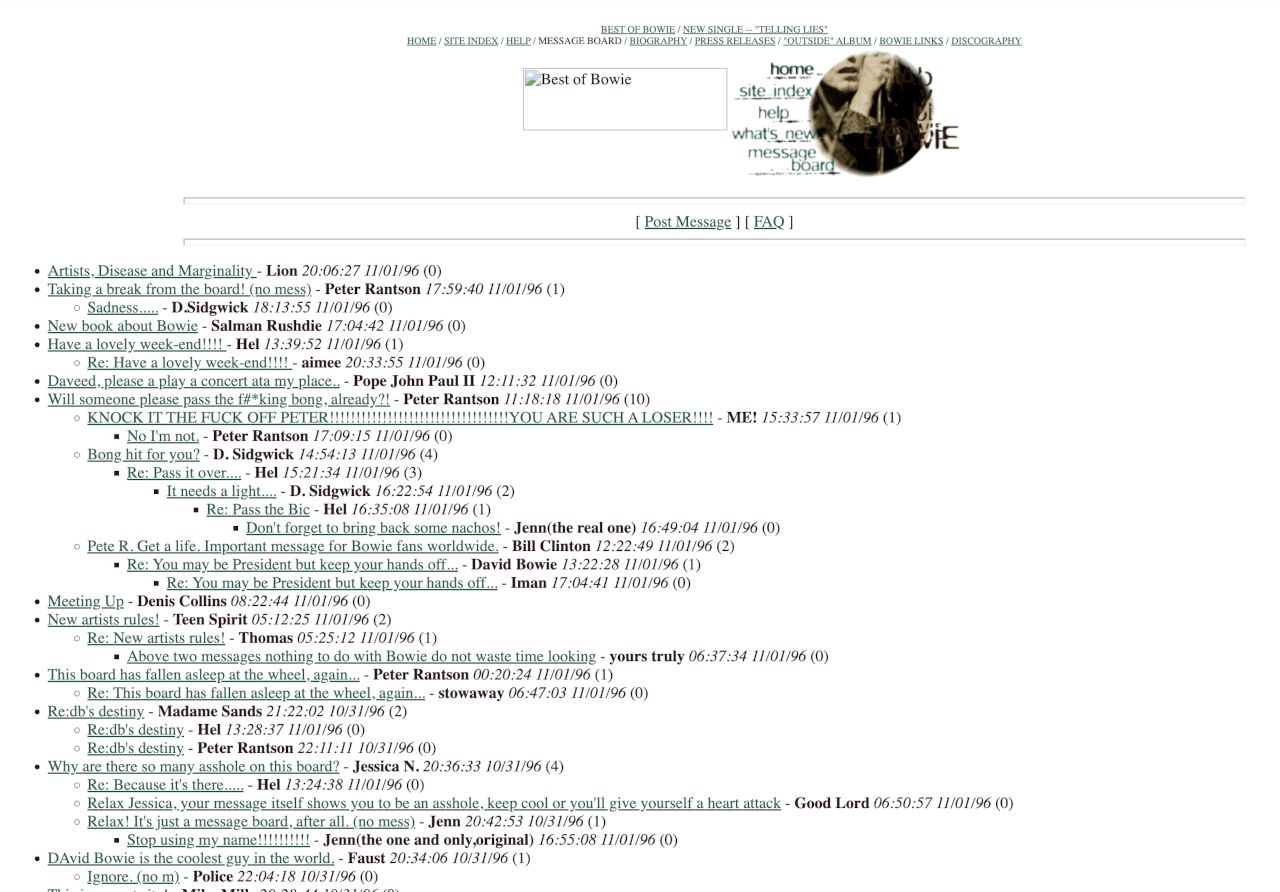
Fan Sites
It wasn’t only artist websites that were emerging over 1996. Fans, too, were increasingly turning to the internet.
At first, it was more common for fans to congregate on the internet via Usenet newsgroups or email mailing lists, both text-based. Netscape Navigator 2.0, for instance, included both an email client (“Netscape Mail”) and a built-in Usenet newsreader (“Netscape News”).
The main Bowie forum at this time was the Usenet group, alt.fan.david-bowie. Its content was akin to what you’d read on a Reddit forum nowadays — opinions on albums, links to articles and interviews, tour information, questions about Bowie’s teeth (“I read an article recently saying that David has new teeth. Anyone know anything about this?”).
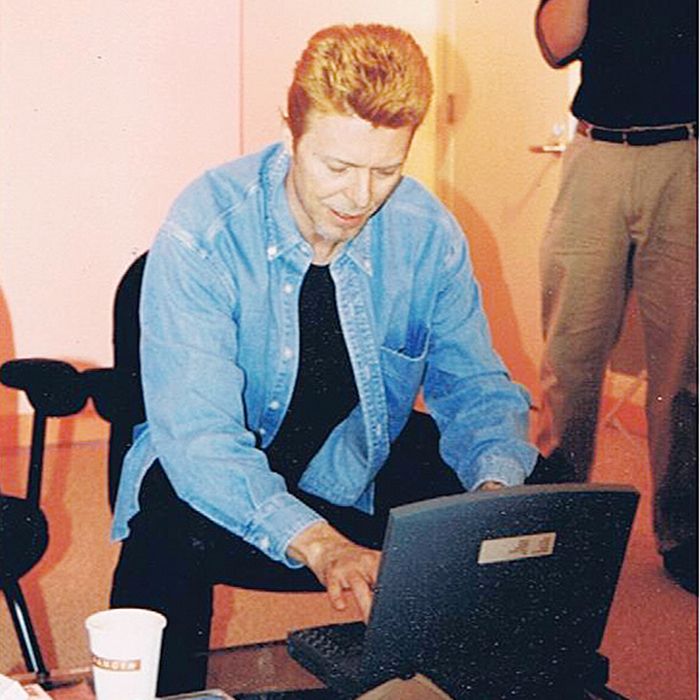
Although Usenet was the primary online platform for music fans in 1996, fan websites were gaining popularity as the web itself inched into the mainstream. The most prominent Bowie fan site at this time was The David Bowie File by Evan Torrie, a New Zealander who had studied computer science at Stanford University in the early 1990s.
Torrie had launched the site in October 1994, “mainly as an experiment in Web content development.” By March 1995, the site was included in the Yahoo directory and then jumped in popularity after the release of Bowie’s Outside album in September 1995.

By early 1996, The David Bowie File included a quote contest and a mechanism for fans to vote on albums and songs. “Traffic leveled off at about 12,000 hits per day (or around 2,500-3,000 page impressions) in early 1996,” Torrie wrote, at which point he paused updates due to illness.
When he returned to the site, in August 1996, he re-named it Teenage Wildlife, after a Bowie song from the 1980 album Scary Monsters (And Super Creeps). Perhaps inspired by Bowie’s own constant identity changes, the new name reinvigorated Torrie. “In early October,” he wrote, “the site moved to a new commercial hosting service, and was rapidly expanded to include additional features such as the Fan Contributions page and the Articles page, and the News page became a true daily update.”
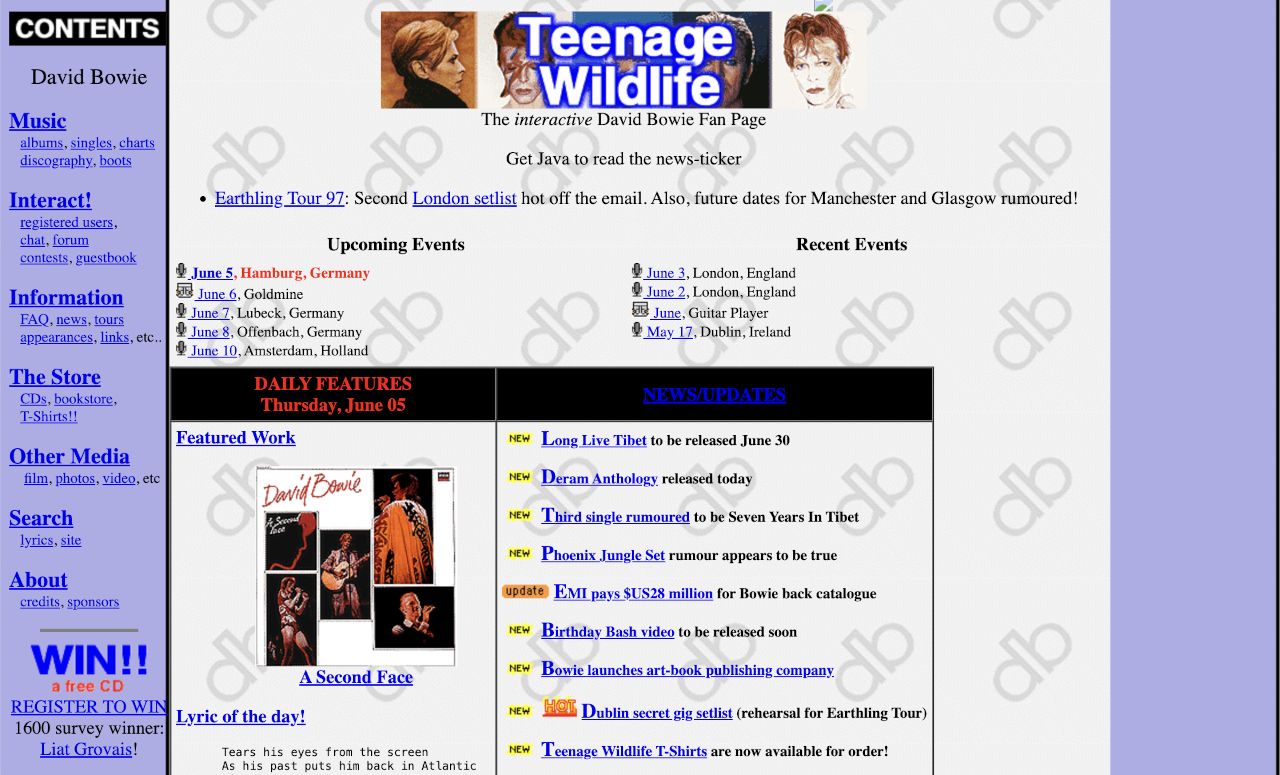
Other Bowie fan sites would soon emerge, such as BowieWonderworld and Bassman’s David Bowie Page, but Torrie’s site was the first of its kind to gain a dedicated following.
Bowie Website v2
Towards the end of 1996, N2K was asked again to re-design Bowie’s website. According to N2K designer Marlene Stoffers, the site had had “four or five different designs” prior to her involvement [according to an interview in the book Creative Web Design by Michael Baumgardt].
Stoffers and fellow N2K designer Ben Clemens were given the job of re-designing the site in time for Bowie’s upcoming 50th birthday in January 1997 and the release of his new album Earthling shortly thereafter. As Stoffers explained:
“N2K, Inc had a contract with Virgin Records to fix it up and repurpose it, but we ended up doing a complete redesign of the whole site. Because of the limited budget, we had to create a whole site in four weeks. It was just Ben and I partnering on the project.”
Stoffers said that at the time she started work on it, the site had “no real navigational structure and a huge volume of content.” She said it had 120 separate web pages.
Given that the current site was a mess of previous overlapping designs, Stoffers and Clemens decided to do “a complete redesign.” They divided the new site into five categories: Earthling (the latest album, due out early-1997), Connection, History, Site Index, Beginning. However, Clemens admitted these were “arbitrary categories” and that it was “difficult to find specific information.”
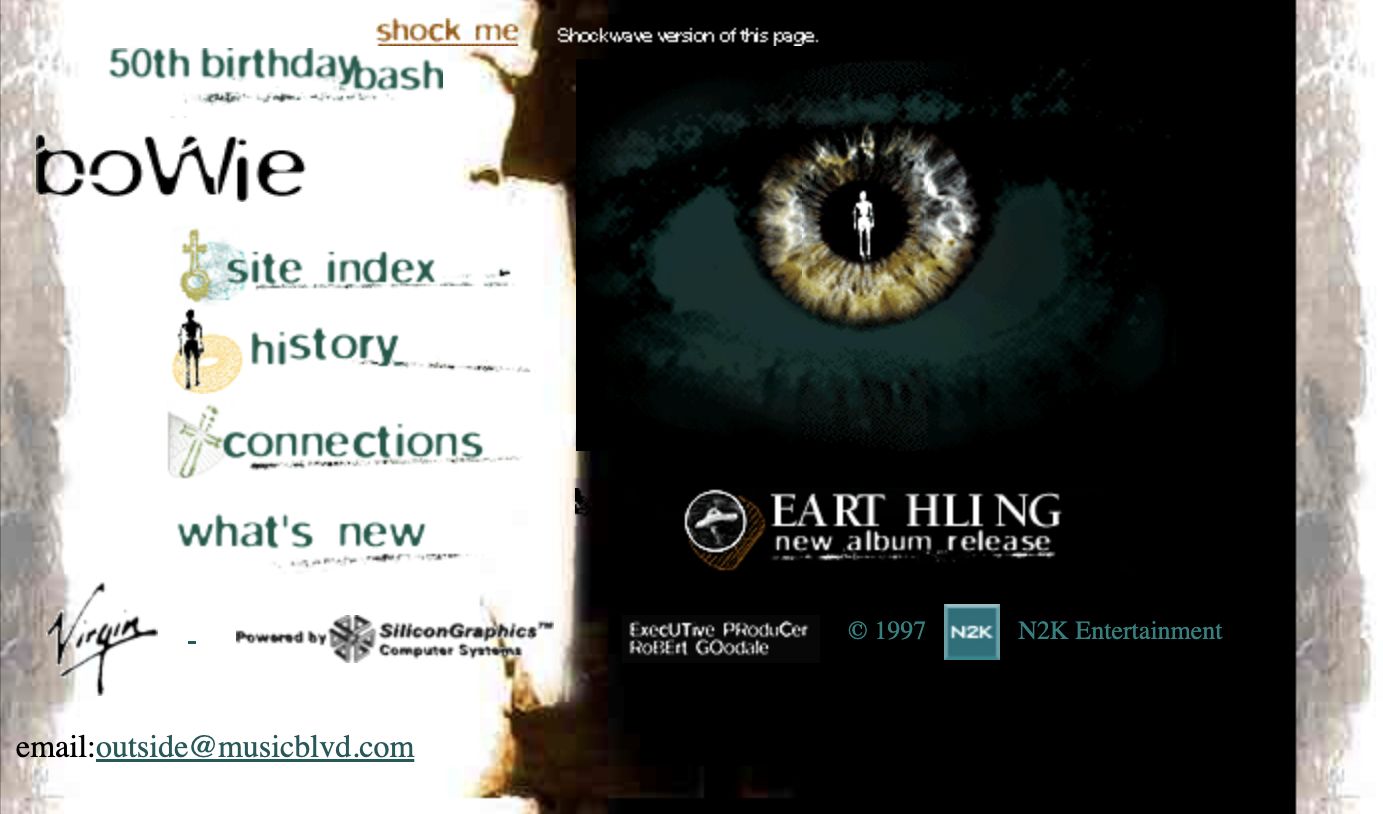
What was more successful was the visual design. The new davidbowie.com had a striking monochrome design, with jagged edges and a grungy texture. For each page, roughly half was black and the other half white — but it varied, so sometimes it was the left side that was dark and sometimes the right. The imagery and menu icons had a fuzzy, alien quality; like something out of The X Files, then into its fourth season. Indeed, one of the images used was a blurred flying saucer, playing on Bowie’s Ziggy Stardust-era reputation as an alien rock star.
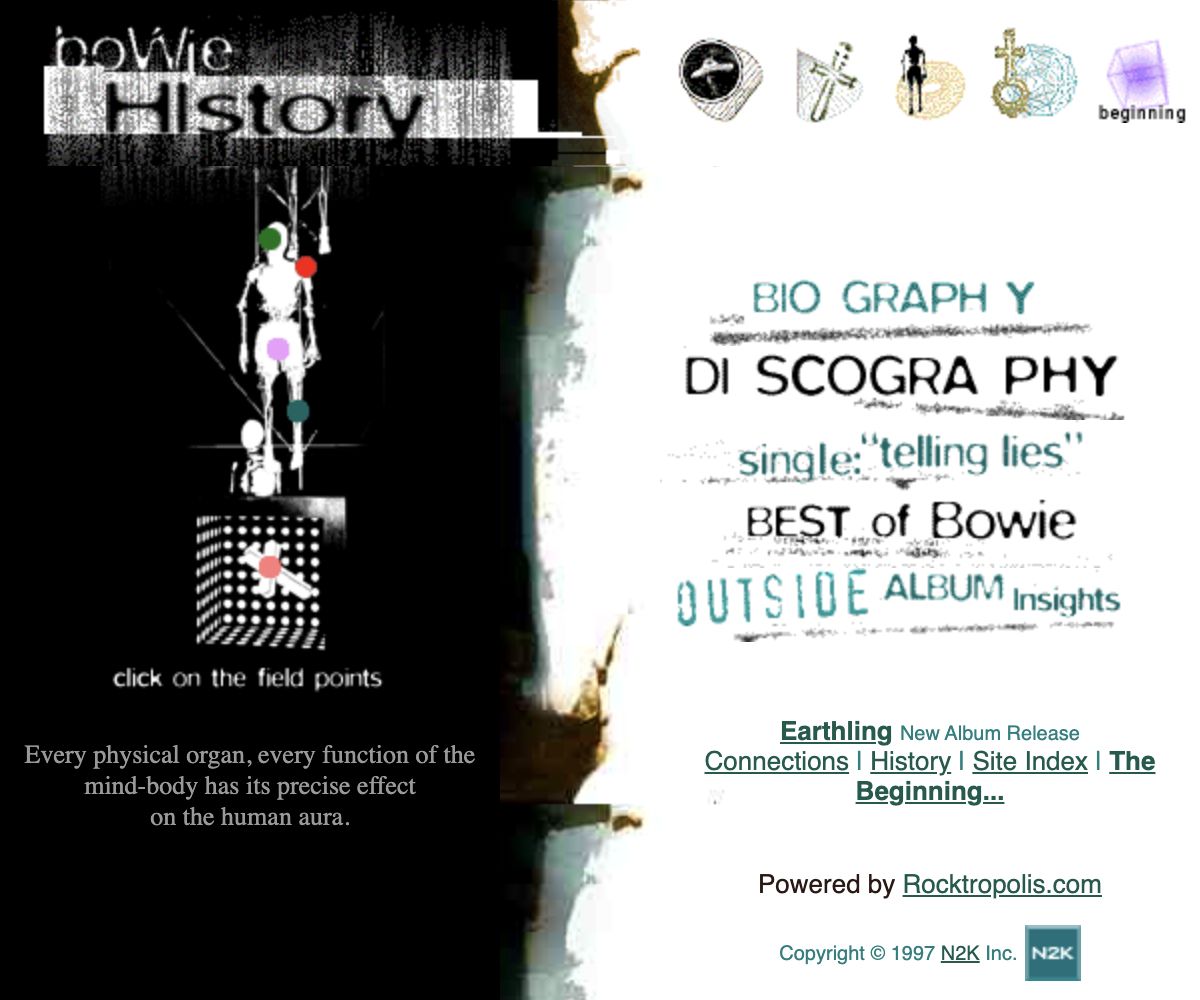
The design was inspired by Kirlian photography, a technique that purported to capture a person’s aura using a special camera. Bowie had been interested in it since the 1970s — he’d been given a Kirlian device during the recording of Station to Station and, at least one time, used it to check his aura before and after taking cocaine. For the Earthling album, Bowie used some of those Kirlian photographs he’d previously taken. An image of his fingertip together with a crucifix his father had given him was reproduced in the album booklet and as the cover art for the “Little Wonder” single.
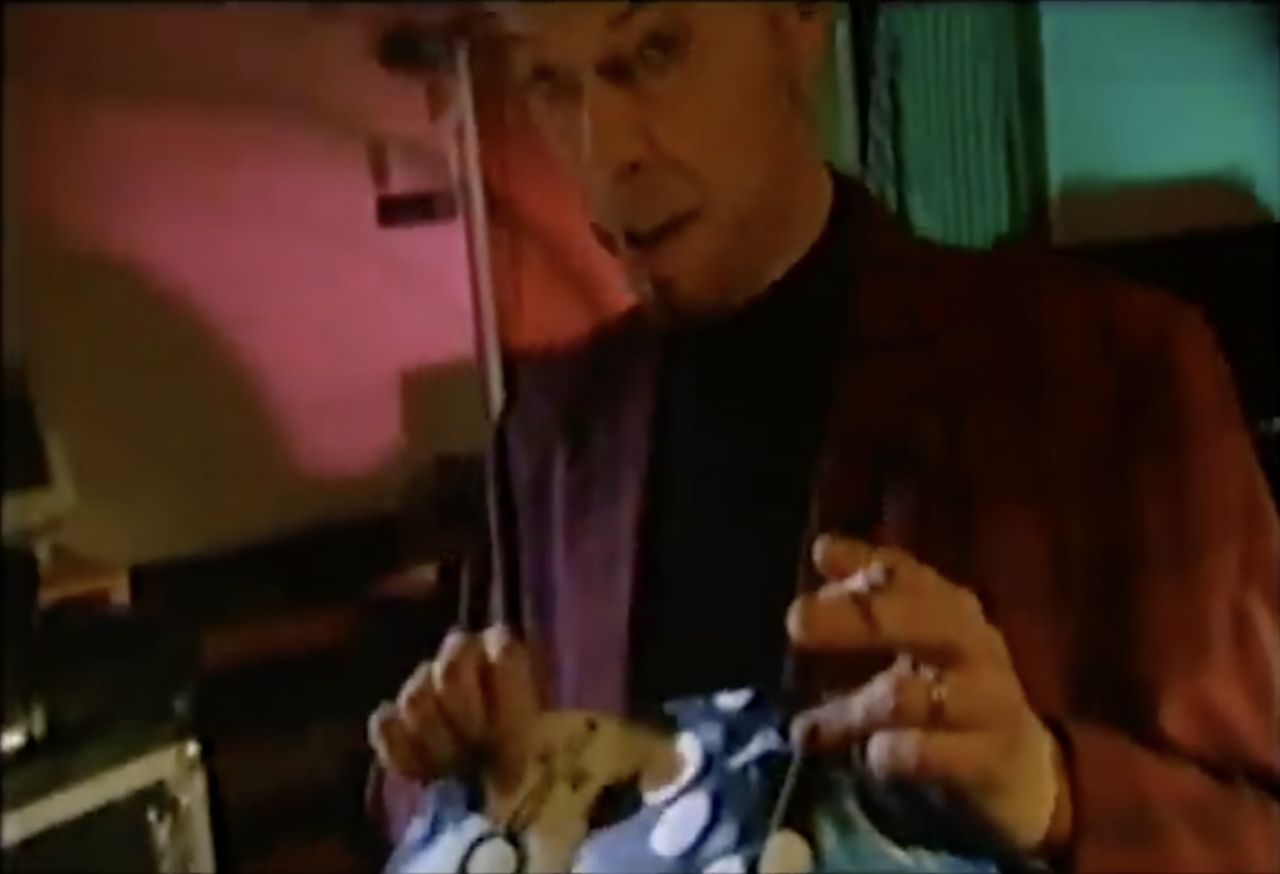
The overall effect of the new website was unsettling yet visually striking, as if Francis Bacon had been the web designer. Despite this, Bowie’s website wasn’t particularly ground-breaking even after the redesign. Although it looked like an artwork and made use of trendy multimedia technologies like Shockwave, there was no true user interaction on the site — it was purely informational.
During the time Bowie’s website was being redeveloped, the concept of web portals was beginning to take hold of the dot-com economy. These were large websites that aggregated various types of information and services; including email, search, online forums, news, financial information, and more. Three of the main Internet search engines — Yahoo!, Lycos, and Excite — all went public in April 1996 and began transforming themselves into web portals.
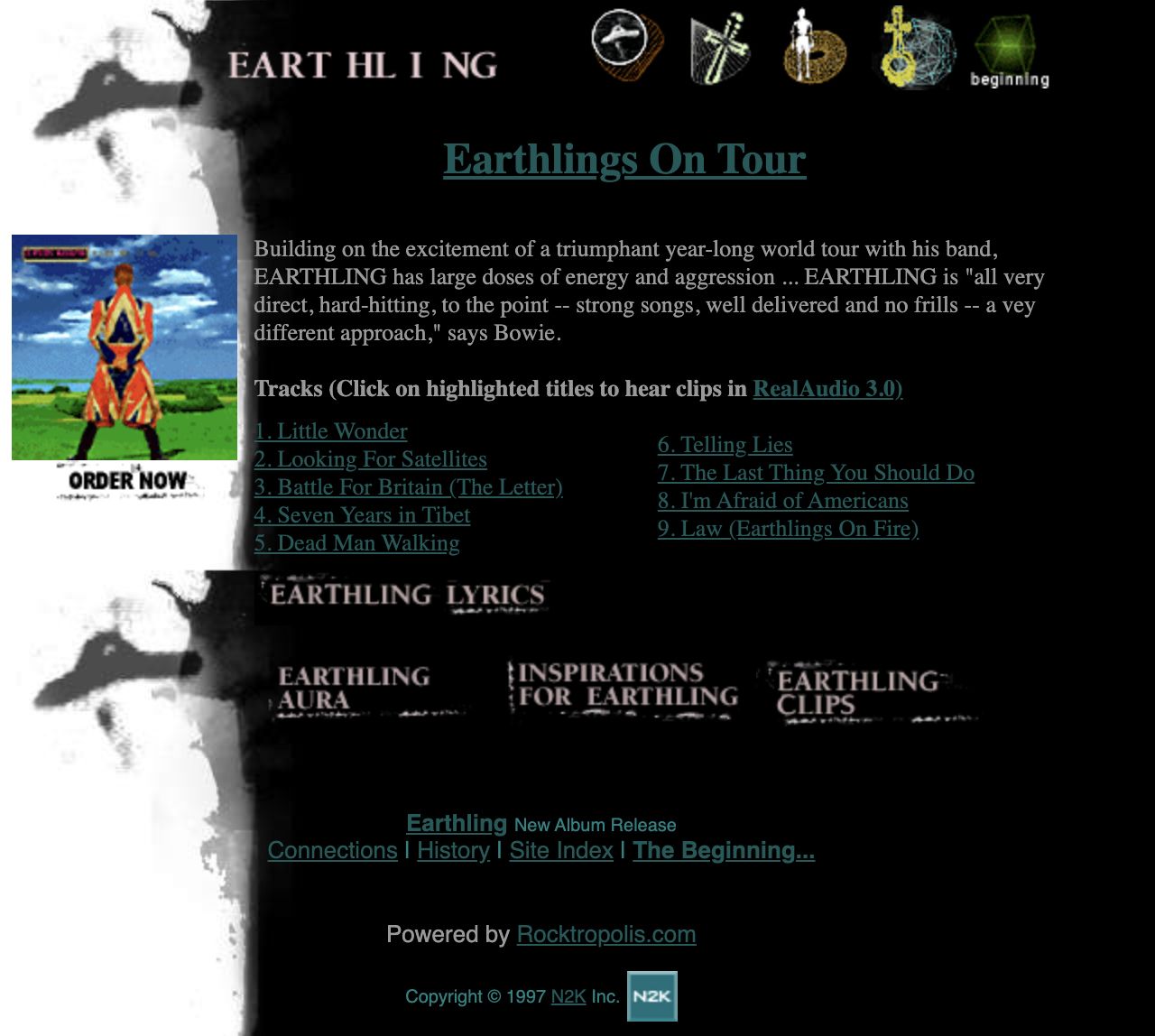
Bowie had also noticed the popularity of fan sites dedicated to his own music and career. He later told Computerworld that he “discussed the idea of integrating them somehow” into his website. That idea “evolved into a sort of quirky portal; an individualized portal that revolves around me and music.” Bowie had recognised that the internet enabled people to create global communities based around specific topics — including himself.
Over the coming year, Bowie and his managers would begin working on the next iteration of his website: what eventually became BowieNet.
This is part of a series of posts about BowieNet and David Bowie's website in the mid-to-late 1990s:
- David Bowie’s Early Websites, 1995–1997: Outside to Earthling
- Telling Lies: Bowie and Online Music Distribution in 1996
- BowieNet: The Inside Story of Its Creation
- Launch of BowieNet and the First Inklings of Social Networks
Buy the Book
My Web 2.0 memoir, Bubble Blog: From Outsider to Insider in Silicon Valley's Web 2.0 Revolution, is now available to purchase:
- Paperback, US$19.99: Amazon; Bookshop.org
- eBook, US$9.99: Amazon Kindle Store; Apple Books; Google Play
Or search for "Bubble Blog MacManus" on your local online bookstore.